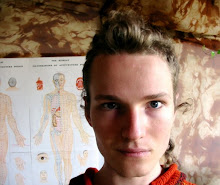
Imagine for a moment - coming home after a long journey.
Venous blood (blue - rich in carbon dioxide and low in O2) arrives in the right atrium of the heart via the inferior (from the lower body) or superior (from the upper body) vena cava. It is then pumped through the atreoventricular (tricuspid) valve into the right ventricle. This valve has strong ligaments attached to it inside the ventricle that prevents the flaps from caving in against the pressure of the ventricular contraction - this holds true for the mitral valve in the left ventricle as well. The right ventricle pumps the venous blood through the pulmonary semilunar valve into the pulmonary artery (this is the only artery to carry deoxygenated blood) and to the lungs. The artery branches off into arterioles and then into capillaries where they interface with the alveolar sacs of the lungs - there is gas diffusion across a distance only two cells thick. The diffusion is a passive process based on relative concentrations of gasses across a mucosal layer. The newly oxygenated (red) blood recollects in the pulmonary veins and enters the left atrium of the heart where it is pumped through the mitral valve into the left ventricle. The atriums are on the top third of the heart and have thinner muscle walls than do the ventricles as their purpose is to load the ventricles with blood and stretch-prime them for contraction. The left ventricle pumps blood into the aorta and from there into all the arteries of the body. Two arteries leave the aorta right above the aortic valve - these are the left and right coronary arteries - they have the important duty of supplying the heart tissue itself with blood. The heart baths itself first in its rhythmic nurturing warmth.

The aorta has a significant amount of stretch. This buffers the circulatory system from the powerful blast of blood erupting from the heart and extends that force over a longer duration with its elastic muscular recoil pushing arterial blood through the body. This muscular contraction extends through the major arteries assisting the heart in the process of distributing warm pulsations of oxygen and nutrient rich blood. The vessels are also capable of vasoconstriction and vasodilation - this is how the body is able to regulate where blood resources are directed based upon tissue needs and sympathetic / parasympathetic stimulation. Passing down from arterioles to capillaries, nutrients, oxygen and other gasses pass out of the blood into the interstitial fluid and from there pass through the cellular membranes into the cells themselves.
Cellular respiration!
The cells expel CO2 and other metabolic waste much of which returns to the bloodstream via the interstitial fluid on the venous side of the capillary isorings, then venules, veins, and eventually the vena cava and the right atrium of the heart. The veins are not heavily muscled like the arteries and depend a great deal on movement and skeletal muscles to act as a secondary pump to assist venous flow. Throughout the veins are valves which prevent venous blood from flowing back into the system due to gravity. The venous blood has a swooshing quality like waves lapping at the shore endlessly with a nurturing and self-nourishment quality of returning to the center for replenishment. It is warm and earthy and nurturing in contrast to the strong rhythmic arterial pulsations of nourishment outward.
Blood also passes glands to pick up endocrine messages for general distribution; through the gut to retrieve nutrients and fluid to pass along to the liver which filters toxins and transforms, stores, and distributes nutrients; through the kidneys to filter urea...
Breath is also involved in circulation by decreasing the pressure in the thoracic cavity and sucking venous blood towards the center. By virtue of the pericardial sack being attached to the diaphragm and the posterior sternum, breath creates space for increased stroke volume.
blood is a living fluid organ.
bathing you endlessly.
from the heart.
and returning to the center.
for a soundtrack:
A Soothing Edge

No comments:
Post a Comment